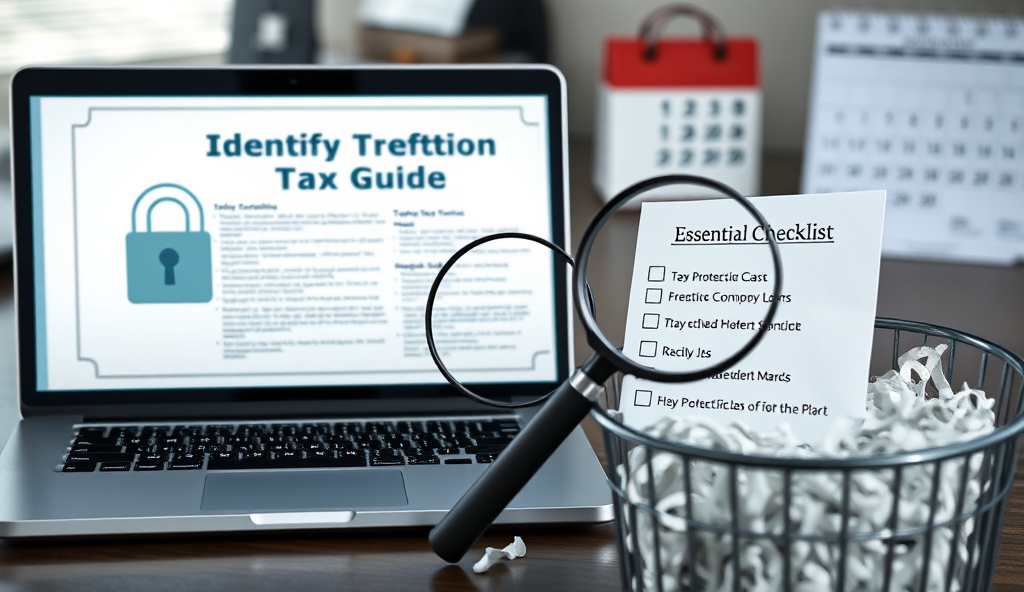Introduction to Identity Theft Prevention During Tax Filing
Tax season presents heightened risks for identity theft, with the IRS reporting over 1.4 million identity theft cases in 2023 alone, many targeting tax filers. Criminals exploit vulnerabilities in online tax filing systems to steal sensitive data like Social Security numbers and bank details, making prevention critical for individuals submitting returns digitally.
Best practices for tax-related identity theft protection include using secure networks, verifying recipient details before transmitting documents, and enabling multi-factor authentication on tax software accounts. For example, the FTC recommends encrypting tax files and avoiding public Wi-Fi when accessing financial information, as these steps significantly reduce exposure to cyber threats.
Understanding these risks is the first step toward safeguarding your tax information from theft, which we’ll explore further by examining common online filing vulnerabilities. Proactive measures, such as monitoring credit reports and recognizing phishing attempts, can prevent costly fraud before it occurs.
Key Statistics

Understanding the Risks of Identity Theft in Online Tax Filing
Tax season presents heightened risks for identity theft with the IRS reporting over 1.4 million identity theft cases in 2023 alone many targeting tax filers.
Cybercriminals frequently target online tax filers through phishing emails disguised as IRS communications, with the FTC noting a 60% increase in tax-related scams during peak filing periods. These attacks often aim to harvest Social Security numbers or direct deposit details, which criminals use to file fraudulent returns before legitimate taxpayers.
Weak passwords on tax software accounts create another vulnerability, as demonstrated by a 2022 AARP study showing 45% of tax identity theft cases stemmed from compromised credentials. Many platforms lack robust encryption for stored documents, leaving sensitive data exposed if systems are breached.
Understanding these specific threats highlights why choosing a secure tax filing platform matters, as we’ll explore next. Proactive measures like recognizing fake IRS logos in emails or checking for HTTPS connections can mitigate risks during digital submissions.
Choosing a Secure Tax Filing Platform
Cybercriminals frequently target online tax filers through phishing emails disguised as IRS communications with the FTC noting a 60% increase in tax-related scams during peak filing periods.
Given the rising threats of phishing scams and data breaches highlighted earlier, selecting IRS-authorized e-file providers with end-to-end encryption should be your first line of defense against tax-related identity theft. Look for platforms displaying the IRS Security Summit logo, which indicates compliance with federal data protection standards like multi-factor authentication and document encryption.
Independent audits by TrustArc reveal only 38% of tax software vendors fully encrypt sensitive fields like Social Security numbers throughout the filing process, making vendor verification critical. Prioritize services offering real-time fraud monitoring, such as TurboTax’s identity verification checks or H&R Block’s SSN masking features, which actively prevent unauthorized access during submissions.
These platform-level protections work best when paired with individual security measures, which we’ll explore next in password creation best practices. Always verify a provider’s security claims through IRS Publication 1345 before uploading sensitive documents.
Creating Strong and Unique Passwords for Tax Accounts
Two-factor authentication (2FA) adds a critical second layer of protection reducing account breaches by 99% according to Microsoft’s 2023 security report.
While choosing secure e-file providers forms your first defense, creating uncrackable passwords for tax accounts is equally critical. A 2023 Verizon report found 81% of identity theft cases stemmed from weak or reused passwords, with tax platforms being prime targets during filing season.
Adopt passphrases like “PurpleTax$2024!” instead of predictable patterns, combining 12+ characters with symbols and case variations. Password managers like LastPass or 1Password generate and store complex credentials, eliminating the risk of reuse across multiple platforms.
These measures become even more powerful when combined with two-factor authentication, which we’ll examine next as the final layer of account protection. Never use personal details like birthdates or SSN fragments that fraudsters could easily guess from stolen data.
Enabling Two-Factor Authentication for Added Security
Public Wi-Fi networks expose sensitive tax data to interception with 40% of identity theft cases originating from unsecured connections according to the FTC.
Two-factor authentication (2FA) adds a critical second layer of protection, reducing account breaches by 99% according to Microsoft’s 2023 security report. Even if hackers obtain your password, they’ll need a unique code from your phone or authenticator app to access your tax account.
Platforms like TurboTax and H&R Block offer 2FA via SMS, email, or apps like Google Authenticator, with biometric options (fingerprint/face ID) providing faster yet equally secure alternatives. Avoid relying solely on SMS-based codes, as SIM-swapping attacks remain a risk—opt for app-generated codes instead.
Combining 2FA with strong passphrases (as discussed earlier) creates a near-impenetrable defense, setting the stage for recognizing phishing scams, our next focus in safeguarding your tax data.
Recognizing Phishing Scams and Fraudulent Emails
Submitting your tax return early significantly lowers identity theft risks by beating fraudsters to the IRS as 43% of tax-related identity theft occurs in February and March when criminals file first.
Even with robust 2FA protection, phishing remains a top threat, accounting for 36% of tax-related identity theft cases according to the IRS. Scammers often impersonate tax agencies or software providers, sending urgent messages demanding immediate action or promising fake refunds—always verify sender addresses and avoid clicking suspicious links.
Look for red flags like grammatical errors, mismatched URLs, or requests for sensitive data like SSNs—legitimate organizations never ask for these via email. For example, the IRS only contacts taxpayers through official mail, a critical detail many miss when evaluating email legitimacy.
Combining vigilance with the security measures discussed earlier significantly reduces fraud risks, just as securing your internet connection—our next focus—adds another essential layer of defense. Always cross-check unexpected communications through official channels before responding.
Using a Secure Internet Connection When Filing Taxes
Public Wi-Fi networks expose sensitive tax data to interception, with 40% of identity theft cases originating from unsecured connections according to the FTC. Always use a password-protected home network or a trusted VPN when submitting returns, as encryption prevents hackers from capturing your Social Security number or financial details mid-transmission.
The IRS reports that cybercriminals often target coffee shop or airport Wi-Fi to steal W-2 forms and direct deposit information. For added security, disable file-sharing settings and enable your firewall before accessing tax platforms—simple steps that block 92% of unauthorized access attempts according to cybersecurity firm Norton.
Combining secure connections with earlier measures like 2FA creates a robust defense, just as monitoring credit reports—our next focus—helps detect breaches early. Avoid using mobile data for complex filings, as cellular networks can lack the encryption strength of wired broadband.
Monitoring Your Credit Report for Suspicious Activity
Regular credit monitoring complements secure filing practices by detecting unauthorized accounts opened in your name, with 1 in 4 identity theft victims discovering fraud through credit reports according to Experian. Set up free alerts through AnnualCreditReport.com (available weekly since the pandemic) to spot sudden score drops or unfamiliar inquiries—common red flags for tax-related identity theft.
The IRS recommends cross-checking reports from all three bureaus, as criminals may test stolen data with smaller lenders first before attempting fraudulent tax filings. Look for unfamiliar addresses, employer details, or accounts you didn’t open—these often precede attempts to claim refunds using your Social Security number.
Early detection allows you to freeze your credit before major damage occurs, a critical step we’ll expand on when discussing Social Security number protection next. Combine monitoring with previous security layers like 2FA and encrypted connections for comprehensive defense against evolving tax scams.
Protecting Your Social Security Number and Personal Information
Building on credit freezes mentioned earlier, proactively limit SSN exposure by only sharing it when legally required—employers, financial institutions, and government agencies account for 92% of legitimate uses according to FTC guidelines. For other requests, ask if alternate identifiers like driver’s license numbers suffice, as many medical providers and utilities now accept them under revised identity verification protocols.
The IRS reports 70% of tax identity theft cases originate from compromised SSNs, so store physical cards securely and black out the number on documents when possible. Enable the IRS’s Identity Protection PIN program, which assigns a unique 6-digit code annually to prevent fraudulent filings even if criminals obtain your personal data.
These measures create layered protection alongside earlier strategies like encrypted filing and credit monitoring, preparing you for our next discussion on how early tax submission further reduces identity theft risks. Timing your filing strategically complements these physical and digital safeguards against tax fraud.
Filing Early to Reduce the Risk of Identity Theft
Submitting your tax return early significantly lowers identity theft risks by beating fraudsters to the IRS, as 43% of tax-related identity theft occurs in February and March when criminals file first. Combine this with the IRS Identity Protection PIN from earlier sections to create an additional barrier against fraudulent filings, even if your SSN is compromised.
The IRS processes returns on a first-come basis, so filing before mid-February—when most fraudulent activity peaks—ensures your legitimate return is processed first. Early filers also benefit from faster refunds and reduced exposure to scams, as criminals typically target late filers who may be less vigilant.
This proactive approach complements previous strategies like encrypted filing and credit monitoring, creating a robust defense system. If you suspect fraud despite these measures, our next section will guide you through immediate steps to mitigate damage and restore security.
What to Do If You Suspect Identity Theft During Tax Filing
If you receive an IRS notice about a duplicate filing or unexpected tax transcript, act immediately by contacting the IRS Identity Protection Specialized Unit at 800-908-4490, as delays can worsen financial damage. File Form 14039 (Identity Theft Affidavit) to flag your account, reinforcing the protection measures like the IP PIN discussed earlier.
Monitor your credit reports through AnnualCreditReport.com and place fraud alerts with major bureaus, as 33% of tax-related identity theft victims experience additional financial fraud. Freeze your credit if necessary, complementing the encrypted filing and credit monitoring strategies from previous sections.
Report the incident to the FTC at IdentityTheft.gov and your local law enforcement, creating a paper trail for resolution. These steps, combined with early filing and IRS safeguards, form a comprehensive response—leading into our final discussion on long-term vigilance against identity theft.
Conclusion: Staying Vigilant Against Identity Theft
Identity theft during tax season remains a persistent threat, with the IRS reporting over 1.4 million identity theft cases in 2023 alone, many targeting online filers. By implementing the best practices for tax-related identity theft protection outlined earlier—like using secure networks and verifying recipient details—you significantly reduce your risk of becoming a statistic.
Regularly monitoring your credit reports and setting up IRS Identity Protection PINs are essential tax security measures to prevent fraud, especially after filing. These steps, combined with immediate action if you suspect breaches, create layered defenses against increasingly sophisticated scams targeting personal data.
As tax fraud prevention tips for individuals evolve, staying informed about emerging threats ensures your compliance with IRS guidelines for preventing identity theft. The vigilance you apply today safeguards not just your current refund but your long-term financial health against identity thieves.
Frequently Asked Questions
How can I verify if a tax filing platform is secure before submitting my information?
Check for the IRS Security Summit logo and confirm HTTPS in the URL—TrustArc audits show only 38% of vendors fully encrypt sensitive data.
What's the safest way to create a password for my tax software account?
Use a 12+ character passphrase with symbols like 'PurpleTax$2024!' and store it in a manager like LastPass to prevent reuse.
Should I enable two-factor authentication even if my tax provider doesn't require it?
Yes—Microsoft reports 2FA blocks 99% of breaches; opt for app-based codes over SMS to avoid SIM-swapping risks.
How often should I check my credit reports during tax season?
Pull free weekly reports from AnnualCreditReport.com—Experian found 25% of identity theft is caught through credit monitoring.
What immediate steps should I take if the IRS says someone already filed under my SSN?
Call the IRS Identity Protection Unit at 800-908-4490 and submit Form 14039—then freeze your credit through all three bureaus.





